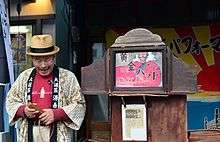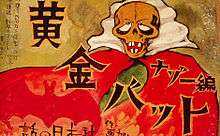Kamishibai

Kamishibai (Japanese: 紙芝居, literally "paper play") is a form of Japanese street theatre and storytelling that was popular during the Depression of the 1930s and the post-war period in Japan until the advent of television during the twentieth century. Kamishibai was told by a kamishibaiya (kamishibai narrator) who would travel to street corners with sets of illustrated boards that he or she placed in a miniature stage-like device and narrated the story by changing each image.[1] Kamishibai has its earliest origins in Japanese Buddhist temples where Buddhist monks from the eighth century onward used emakimono ("picture scrolls") as pictorial aids for recounting their history of the monasteries, an early combination of picture and text to convey a story.[2]
History
Origins
The exact origins of kamishibai during the twentieth century are unknown, appearing "like the wind on a street corner" in the Shitamachi section of Tokyo around 1930.[3] It is believed, however, that kamishibai has deep roots in Japan’s etoki ("pictorial storytelling") art history, which can be traced back to the twelfth century emaki scrolls, such as the Choju giga ("Frolicking Critters") attributed to the priest Toba Sojo (1053-1140).[4] The scroll depicts anthropomorphised animal caricatures that satirise society during this period but has no text, making it a pictorial aid to a story.[5] It can therefore be considered a direct precursor of kamishibai.
During the Edo period (1603-1868) there was a flourishment of the visual and performance arts particularly through proliferation of ukiyo-e ("pictures of the floating world"). Etoki once again became popular during the later eighteenth century as storytellers began to set up on street corners with an unrolled scroll hanging from a pole.[6] In the Meiji Period (1868-1912) tachie ("stand-up pictures"), similar to those in the Edo period, were told by performers who manipulated flat-paper cut-outs of figures mounted on wooden poles (similar to the shadow puppets of Indonesia and Malaysia).[6] The Zen priest Nishimura is also credited to have used these pictures during sermons to entertain children.[6] Another form of etoki was the Japanese modified ‘stereoscope’ imported from Holland. Much smaller in size, six engravings of landscapes and everyday scenes would be placed one behind the other on top of the device and lowered when required so that the viewer, who looked at them through a lens, could experience the illusion of space created by this device.[7] The artistic and technological developments of the Edo and Meiji periods can be linked to the establishment of kamishibai.
Golden age
Kamishiabi, cartoons and comics became substantially popular during the Great Depression of the 1930s and after the Japanese surrender to the Allied Forces in August 1945 at the end of the Second World War.[8] This period is known as the "Golden Age" of kamishibai in Japan.[9] Kamishibai produced and narrated over this period gives insight into the mindset of the people who lived through such a tumultuous period in history. Contrary to the hardships imposed by the depression, in 1933 there were 2,500 kamishibaiya in Tokyo alone, who performed ten times a day for audiences of up to thirty children, equalling a total of one million children a day.[10] The Depression years were the most prosperous and vibrant for kamishibai, with 1.5 million unemployed in Tokyo in 1930 it provided a great job opportunity for many people.[11]
The early post-war period was particularly hard on the citizens of Japan who wanted to rebuild their lives in a rapidly changing environment. Comics became popular, in newspapers and magazines depicting scenes of everyday life injected with humour.[12] A strong publishing industry emerged from the demand for comics, but outside of this industry the desire for cheap entertainment provoked the establishment of new comic outdoor storytelling, kamishibai.[1] Five million children and adults were entertained across Japan daily during the post-war period.[3]
The gaito kamishibaiya ("street-corner kamishibai storyteller") parked their bicycle at a familiar intersection and banged their hiyogoshi ("clapping sticks") together to announce their presence and create anticipation for the show. When the audience arrived they would sell sweets to the children as a ‘fee’ for the show, which was their main source of income. They would then unfold a butai, a ‘miniature wooden proscenium’ which held the illustrated boards for the narrator to change as he narrated (and provided sound effects for) the unscripted story.[13] True artists only used hand-painted original art, not the mass-produced kind found in schools or for other communication purposes.[14]
Kamishibai kashimoto (dealers) were sought to commission and rent artwork to narrators for a small fee.[15] The creation of these boards was similar to that of an American comic book company with each person separately doing the colouring of a panel. The principle illustrator would make pencil sketches that were then done over with thick brushes of India ink. Watercolour paint was then applied to delineate the background and foreground, an opaque tempera paint was then added on top and lastly a coat of lacquer to give it shine and protect it from the elements.[16] A mix of ‘trashy pop culture’ and fine artistry kamishibai blended the traditional linear style of Japanese painting with the heavy chiaroscuro of Western painting, contrasting light and dark to give the figures depth and dynamism.[17]
There were a variety of popular stories and themes in kamishibai, which are now seen in contemporary manga and anime, including one of the first illustrated costume superheroes in the world, Ōgon Bat ("Golden Bat") in 1931, superheroes with secret identities like Prince Gamma whose alter ego was a street urchin and the popular genre of gekiga or "drama pictures".[10][18] Many prolific manga artists, like Shigeru Mizuki, were once kamishibai artists before the medium went out of vogue in 1953.[19]

Kamishibai was also utilised as a source of communication to the masses, an ‘evening news’ for adults during the Second World War and the Allied Occupation (1945–1953). There are theories about the acceptance of drawing as a means to communicate in Asian nations more so than in Western nations which can be linked to the different printing technologies utilised in each regions histories. In the West, text and image eventually became separated because of the Gutenberg method of moveable type.[6] In Japanese language of complex characters, it was much easier to employ the woodblock printing method imported from Korea following the military campaigns of 1592 to 1593.[6]
Decline
The popularity of kamishibai declined at the end of the Allied Occupation and the introduction of television, known originally at denki kamishibai ("electric kamishibai") in 1953.[1] With television bringing larger access to a variety of entertainment, many kamishibai artists and narrators lost their work, with the former turning to drawing gekiga bringing new talent and narrative to this growing genre.[20] Although this Japanese art form has largely disappeared, its significance and contributions have allowed kamishibai to be attributed as an origin for both manga and anime.
Modern usage
As a management tool
As part of the Toyota production system, kamishibai boards are used as a visual control for performing audits within a manufacturing process. A series of cards are placed on a board and selected at random or according to schedule by supervisors and managers of the area. This ensures safety and cleanliness of the workplace is maintained and that quality checks are being performed.[21]
Kamishibai performers
Kamishibai storytelling is currently being conducted as part of an ongoing campaign to promote world peace. Maki Saji[22] (a Buddhist nun) created a kamishibai based on the story of one of the many children, Sadako Sasaki, who suffered as a result of the atomic bomb raid on Hiroshima in 1945. In May 2010 she was a delegate at a Meeting of the Treaty on the Non-Proliferation of Nuclear Weapons at the United Nations in New York, where she performed to promote a world in harmony and free of nuclear arms.
See also
- Anime
- Cantastoria
- Emaki
- Light novel
- Manga
- Ōgon Bat
- Shigeru Mizuki (Post WWII Kamishibai artist)
- Tokusatsu
- Toy theater
- Ukiyo-e
- Visual novel
- Yamishibai
References
- 1 2 3 Schodt, Frederik L. (1997). Manga! Manga! The World of Japanese Comics. Tokyo: Kodansha International Ltd. p. 62.
- ↑ Nash, Eric P. (2009). Manga Kamishibai: The Art of Japanese Paper Theatre. New York: Abrams Comicarts. p. 57.
- 1 2 Nash, Eric P. (2009). Manga Kamishibai: The Art of Japanese Paper Theatre. New York: Abrams Comicarts. p. 15.
- ↑ Nash, Eric P. (2009). Manga Kamishibai: The Art of Japanese Paper Theatre. New York: Abrams Comicarts. p. 55.
- ↑ Koyama-Richard, Brigitte (2007). One Thousand Years of Manga. Paris: Flammarion. p. 14.
- 1 2 3 4 5 Nash, Eric P. (2009). Manga Kamishibai: The Art of Japanese Paper Theatre. New York: Abrams Comicarts. p. 61.
- ↑ Koyama-Richard, Brigitte (2007). One Thousand Years of Manga. Paris: Flammarion. p. 75.
- ↑ Schodt, Frederik L. (1997). Manga! Manga! The World of Japanese Comics. Tokyo: Kodansha International Ltd. p. 60.
- ↑ Nash, Eric P. (2009). Manga Kamishibai: The Art of Japanese Paper Theatre. New York: Abrams Comicarts. pp. 15 & 18.
- 1 2 Nash, Eric P. (2009). Manga Kamishibai: The Art of Japanese Paper Theatre. New York: Abrams Comicarts. p. 18.
- ↑ Nash, Eric P. (2009). Manga Kamishibai: The Art of Japanese Paper Theatre. New York: Abrams Comicarts. p. 77.
- ↑ Schodt, Frederik L. (1997). Manga! Manga! The World of Japanese Comics. Tokyo: Kodansha International Ltd. p. 61.
- ↑ Nash, Eric P. (2009). Manga Kamishibai: The Art of Japanese Paper Theatre. New York: Abrams Comicarts. p. 17.
- ↑ Nash, Eric P. (2009). Manga Kamishibai: The Art of Japanese Paper Theatre. New York: Abrams Comicarts. p. 6.
- ↑ Nash, Eric P. (2009). Manga Kamishibai: The Art of Japanese Paper Theatre. New York: Abrams Comicarts. p. 79.
- ↑ Nash, Eric P. (2009). Manga Kamishibai: The Art of Japanese Paper Theatre. New York: Abrams Comicarts. pp. 77–78.
- ↑ Nash, Eric P. (2009). Manga Kamishibai: The Art of Japanese Paper Theatre. New York: Abrams Comicarts. pp. 78–79.
- ↑ Schodt, Frederik L. (1997). Manga! Manga! The World of Japanese Comics. Tokyo: Kodansha International Ltd. p. 66.
- ↑ Schodt, Frederik L. (1996). Dreamland Japan: Writings on Modern Manga. Berkeley: Stone Bridge Press. p. 179.
- ↑ Schodt, Frederik L. (1997). Manga! Manga! The World of Japanese Comics. Tokyo: Kodansha International Ltd. p. 67.
- ↑ Miller, Jon (July 6, 2009). "One Point Lesson: Kamishibai". Gemba Panta Rei. Retrieved 2013-10-07.
- ↑ "ホーム Home". 佐治妙心(佐治麻希) Myoshin Saji (Maki). Archived from the original on March 31, 2012. Retrieved 2013-10-07.
External links
| Wikimedia Commons has media related to Kamishibai. |
- Atelier Kamishibai Artist Community
- Official Kamishibai Artist Forums
- ZiRKUSOFiA Cuentos y Talleres de Kamishibai.
- Doshin-sha kammishibai books (Japanese)
- Kamishibai for Kids (English)
- Storycard Theater
- Kreashibai website and shop (German)
- Review of Manga Kamishibai: The Art of Japanese Paper Theater on PopMatters.com
- Entry in the Encyclopedia of Science Fiction
- Manga's story starts with kamishibai